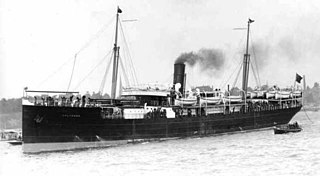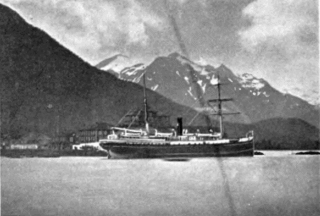Related Research Articles

Charles Julius Guiteau was an American writer and lawyer who assassinated James A. Garfield, president of the United States, on July 2, 1881. Guiteau falsely believed he had played a major role in Garfield's election victory, for which he should have been rewarded with a consulship. He was so offended by the Garfield administration's rejections of his applications to serve in Vienna or Paris that he decided to kill Garfield, and shot him at the Baltimore and Potomac Railroad Station in Washington, D.C. Garfield died two months later from infections related to the wounds. In January 1882, Guiteau was sentenced to death for the crime, and was hanged five months later.

SS Princess Alice, formerly PS Bute, was a British passenger paddle steamer that sank on 3 September 1878 after a collision with the collier Bywell Castle on the River Thames. Between 600 and 700 people died, all from Princess Alice, the greatest loss of life of any British inland waterway shipping accident. No passenger list or headcount was made, so the exact figure of those who died has never been known.

The PS General Slocum was a sidewheel passenger steamboat built in Brooklyn, New York, in 1891. During her service history, she was involved in a number of mishaps, including multiple groundings and collisions.

The Lexington was a paddlewheel steamboat operating along the Northeastern coast of the United States from 1835 to 1840. Commissioned by Cornelius Vanderbilt, it was one of the fastest and most luxurious steamers in operation.
The New York, Providence and Boston Railroad, normally called the Stonington Line, was a major part of the New York, New Haven and Hartford Railroad between New London, Connecticut and Providence, Rhode Island. It is now part of Amtrak's high-speed Northeast Corridor.

SS Celtic was an ocean liner built for the White Star Line by shipbuilders Harland and Wolff of Belfast.

SS Valencia was an iron-hulled passenger steamer built for the Red D Line for service between Venezuela and New York City. She was built in 1882 by William Cramp and Sons, one year after the construction of her sister ship Caracas. She was a 1,598-ton vessel, 252 feet (77 m) in length. In 1897, Valencia was deliberately attacked by the Spanish cruiser Reina Mercedes off Guantanamo Bay, Cuba. The next year, she became a coastal passenger liner on the U.S. West Coast and served periodically in the Spanish–American War as a troopship to the Philippines. Valencia was wrecked off Cape Beale, which is near Clo-oose, on the west coast of Vancouver Island, British Columbia, on 22 January 1906. As her sinking killed 100 people, some classify the wreck of Valencia as the worst maritime disaster in the "Graveyard of the Pacific", a famously treacherous area off the southwest coast of Vancouver Island.

Pacific was a wooden sidewheel steamer built in 1850 most notable for its sinking in 1875 as a result of a collision southwest of Cape Flattery, Washington. Pacific had an estimated 275 passengers and crew aboard when she sank. Only two survived. Among the casualties were several notable figures, including the vessel's captain at the time of the disaster, Jefferson Davis Howell (1846–1875), the brother-in-law of former Confederate President Jefferson Davis. The sinking of Pacific killed more people than any other marine disaster on the West Coast at the time.

SS Arctic was a 2,856-ton paddle steamer, one of the Collins Line, which operated a transatlantic passenger and mail steamship service during the 1850s. She was the largest of a fleet of four, built with the aid of U.S. government subsidies to challenge the transatlantic supremacy of the British-backed Cunard Line. During its four-year period of service, the ship was renowned both for its speed and for the luxury of its accommodation.

The steamboat Dix operated from 1904 to 1906 as part of the Puget Sound Mosquito Fleet. She was sunk in a collision which remains one of the most serious transportation accidents in the state of Washington to this day.

Bristol was a large sidewheel steamboat launched in 1866 by William H. Webb of New York for the Merchants Steamship Company. One of Narragansett Bay's so-called "floating palaces", the luxuriously outfitted Bristol and her sister ship Providence, each of which could carry up to 1,200 passengers, were installed with the largest engines then built in the United States, and were considered to be amongst the finest American-built vessels of their era.

Providence was a large sidewheel steamer launched in 1866 by William H. Webb of New York for the Merchants Steamship Company. The first of Narragansett Bay's so-called "floating palaces", the luxuriously outfitted Providence and her sister ship Bristol, each of which could carry up to 1,200 passengers, were installed with the largest engines then built in the United States, and were considered to be amongst the finest American-built vessels of their era.

SS Volturno was an ocean liner that caught fire and was eventually scuttled in the North Atlantic in October 1913. She was a Royal Line ship under charter to the Uranium Line at the time of the fire. After the ship issued SOS signals, eleven ships came to her aid and, in heavy seas and gale winds, rescued 521 passengers and crewmen. In total 135 people, most of them women and children in lifeboats launched unsuccessfully prior to the arrival of the rescue ships, died in the incident.

SS La Bourgogne was a French ocean liner, which sank in a collision July 1898, with the loss of 549 lives. At the time this sinking was infamous, because only 13% of the passengers survived, while 48% of the crew did. In 1886 she set a new record for the fastest Atlantic crossing by a postal steamer.
SS Vesta was a propeller-driven fishing vessel 250 gross tons, built in 1853 at Nantes, France, by Hernoux et Cie of Dieppe for the Société Terreneuvienne of Granville in Normandy. That firm had extensive fishing interests in the Grand Banks area off Newfoundland, which it operated from a base in Saint Pierre Island. On 27 September 1854 Vesta was eastbound with a crew of 50, returning 147 fisherman and salters home. In a heavy fog, Vesta collided with the Collins Line passenger paddle steamer SS Arctic. A ten-foot section of Vesta's bow was sheared off, but the watertight bulkhead behind the bow remained intact and kept out the sea, keeping the vessel afloat.

SS Columbia (1880–1907) was a cargo and passenger steamship that was owned by the Oregon Railway and Navigation Company and later the San Francisco and Portland Steamship Company. Columbia was constructed in 1880 by the John Roach & Sons shipyard in Chester, Pennsylvania for the Oregon Railway and Navigation Company.

Commonwealth was a large sidewheel steamboat built in 1854–55 for passenger service on Long Island Sound. The most celebrated Sound steamer of her day, Commonwealth was especially noted for the elegance and comfort of her passenger accommodations, which included gas lighting, steam heating, and an "enchantingly beautiful" domed roof in her upper saloon. Her stability of motion led her captain to describe Commonwealth as the finest rough weather steamboat ever built in the United States.

SS George W. Elder (1874–1935) was a passenger/cargo ship. Originally a U.S. east coast steamer, she was built by John Roach & Sons in Chester, Pennsylvania. The George W. Elder became a west coast steamer in 1876 and served with the Oregon Steamship Company, Oregon Railroad and Navigation Company, San Francisco and Portland Steamship Company and the North Pacific Steamship Company. In 1907, the George W. Elder helped to rescue the survivors of her former running mate Columbia. The last owners of the George W. Elder were a Chilean firm which operated her under the name America. She operated the Chilean Coast under this guise until 1935, when she was finally scrapped. The location of her scrapping remains unknown.

SS San Juan was a passenger steamship owned by the Los Angeles and San Francisco Navigation Company. Previously, she was owned by the Pacific Mail Steamship Company and White Flyer Line. At the age of 47 years, San Juan was involved in a collision with the steel-hulled oil tanker S.C.T. Dodd. Because of her aged iron hull, San Juan was fatally damaged in the collision and sank three minutes later, killing 65 people. The loss of San Juan was strikingly similar to the loss of Columbia.
The SS G. P. Griffith was a passenger steamer that burned and sank on Lake Erie on 17 June 1850, resulting in the loss of between 241 and 289 lives. The destruction of the G. P. Griffith was the greatest loss of life on the Great Lakes up to that point, and remains the third-greatest today, after the SS Eastland in 1915 and the Lady Elgin in 1860.
References
- ↑ "Long Island Sound, CT Two Steamers Collide, June 1880." available online
- ↑ New York Times. "THE CRASH ON THE SOUND; INQUIRY INTO THE LOSS OF THE NARRAGANSETT." July 17, 1880. The article summarizes or quotes testimony from both captains. available online
- ↑ Gen Disasters website
- ↑ Unknown Victium from the Narragansett
- ↑ Candice Millard, Destiny of the Republic: a Tale of Madness, Medicine, and the Murder of a President. New York: Doubleday, 2011, ISBN 9780385526265. (Prologue).
- ↑ Greg Rhodes & John Snyder, Redleg Journal. Year By Year and Day by Day with the Cincinnati Reds Since 1866. Road West Publishing, 2001, ISBN 9780964140257.